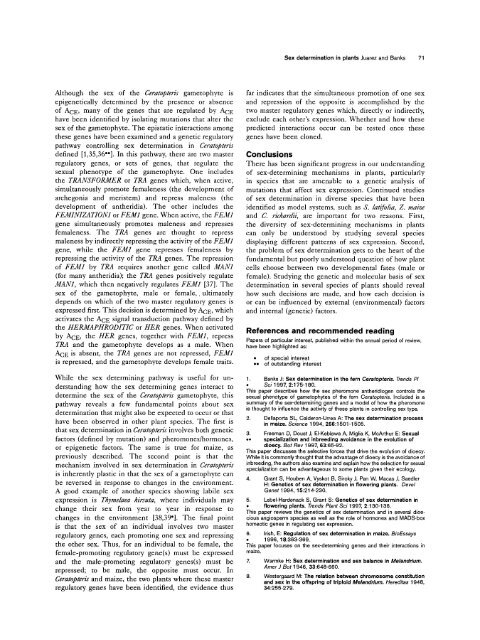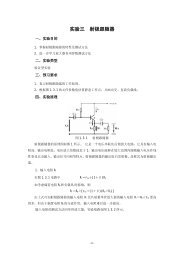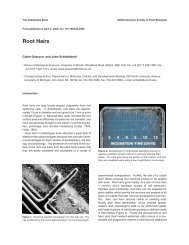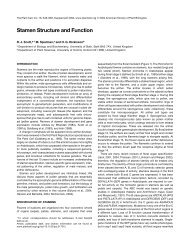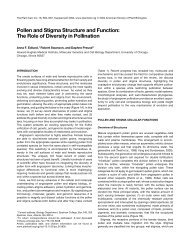Sex determination in plants Cristina Juarez and Jo Ann Banks*
Sex determination in plants Cristina Juarez and Jo Ann Banks*
Sex determination in plants Cristina Juarez and Jo Ann Banks*
Create successful ePaper yourself
Turn your PDF publications into a flip-book with our unique Google optimized e-Paper software.
<strong>Sex</strong> <strong>determ<strong>in</strong>ation</strong> <strong>in</strong> <strong>plants</strong> <strong>Juarez</strong> <strong>and</strong> Banks 71Although the sex of the Ceratopteris gametophyte isepigenetically determ<strong>in</strong>ed by the presence or absenceof ACE, many of the genes that are regulated by ACEhave been identified by isolat<strong>in</strong>g mutations that alter thesex of the gametophyte. The epistatic <strong>in</strong>teractions amongthese genes have been exam<strong>in</strong>ed <strong>and</strong> a genetic regulatorypathway controll<strong>in</strong>g sex <strong>determ<strong>in</strong>ation</strong> <strong>in</strong> Ceratopterisdef<strong>in</strong>ed [1,35,36°°]. In this pathway, there are two masterregulatory genes, or sets of genes, that regulate thesexual phenotype of the gametophyte. One <strong>in</strong>cludesthe TRANSFORMER or TRA genes which, when active,simultaneously promote femaleness (the development ofarchegonia <strong>and</strong> meristem) <strong>and</strong> repress maleness (thedevelopment of antheridia). The other <strong>in</strong>cludes theFEMINIZATION1 or FEM1 gene. When active, the FEM1gene simultaneously promotes maleness <strong>and</strong> repressesfemaleness. The TRA genes are thought to repressmaleness by <strong>in</strong>directly repress<strong>in</strong>g the activity of the FEM1gene, while the FEM1 gene represses femaleness byrepress<strong>in</strong>g the activity of the TRA genes. The repressionof FEM1 by TRA requires another gene called MAN1(for many antheridia); the TRA genes positively regulateMAN1, which then negatively regulates FEM1 [37]. Thesex of the gametophyte, male or female,, ultimatelydepends on which of the two master regulatory genes isexpressed first. This decision is determ<strong>in</strong>ed by ACE, whichactivates the ACE signal transduction pathway def<strong>in</strong>ed bythe HERMAPHRODITIC or HER genes. When activatedby ACE, the HER genes, together with FEM1, repressTRA <strong>and</strong> the gametophyte develops as a male. WhenACE is absent, the TRA genes are not repressed, FEM1is repressed, <strong>and</strong> the gametophyte develops female traits.While the sex determ<strong>in</strong><strong>in</strong>g pathway is useful for underst<strong>and</strong><strong>in</strong>ghow the sex determ<strong>in</strong><strong>in</strong>g genes <strong>in</strong>teract todeterm<strong>in</strong>e the sex of ~he Ceratopteris gametophyte, thispathway reveals a few fundamental po<strong>in</strong>ts about sex<strong>determ<strong>in</strong>ation</strong> that might also be expected to occur or thathave been observed <strong>in</strong> other plant species. The first isthat sex <strong>determ<strong>in</strong>ation</strong> <strong>in</strong> Ceratopteris <strong>in</strong>volves both geneticfactors (def<strong>in</strong>ed by mutation) <strong>and</strong> pheromones/hormones,or epigenetic factors. The same is true for maize, aspreviously described. The second po<strong>in</strong>t is that themechanism <strong>in</strong>volved <strong>in</strong> sex <strong>determ<strong>in</strong>ation</strong> <strong>in</strong> Ceratopterisis <strong>in</strong>herently plastic <strong>in</strong> that the sex of a gametophyte canbe reversed <strong>in</strong> response to changes <strong>in</strong> the environment.A good example of another species show<strong>in</strong>g labile sexexpression is Thymelaea hirsuta, where <strong>in</strong>dividuals maychange their sex from year to year <strong>in</strong> response tochanges <strong>in</strong> the environment [38,39°]. The f<strong>in</strong>al po<strong>in</strong>tis that the sex of an <strong>in</strong>dividual <strong>in</strong>volves two masterregulatory genes, each promot<strong>in</strong>g one sex <strong>and</strong> repress<strong>in</strong>gthe other sex. Thus, for an <strong>in</strong>dividual to be female, thefemale-promot<strong>in</strong>g regulatory gene(s) must be expressed<strong>and</strong> the male-promot<strong>in</strong>g regulatory genes(s) must berepressed; to be male, the opposite must occur. InCeratopteris <strong>and</strong> maize, the two <strong>plants</strong> where these masterregulatory genes have been identified, the evidence thusfar <strong>in</strong>dicates that the simultaneous promotion of one sex<strong>and</strong> repression of the opposite is accomplished by thetwo master regulatory genes which, directly or <strong>in</strong>directly,exclude each other's expression. Whether <strong>and</strong> how thesepredicted <strong>in</strong>teractions occur can be tested once thesegenes have been cloned.ConclusionsThere has been significant progress <strong>in</strong> our underst<strong>and</strong><strong>in</strong>gof sex-determ<strong>in</strong><strong>in</strong>g mechanisms <strong>in</strong> <strong>plants</strong>, particularly<strong>in</strong> species that are amenable to a genetic analysis ofmutations that affect sex expression. Cont<strong>in</strong>ued studiesof sex <strong>determ<strong>in</strong>ation</strong> <strong>in</strong> diverse species that have beenidentified as model systems, such as S. ]atifolia, Z. maize<strong>and</strong> C. richardii, are important for two reasons. First,the diversity of sex-determ<strong>in</strong><strong>in</strong>g mechanisms <strong>in</strong> <strong>plants</strong>can only be understood by study<strong>in</strong>g several speciesdisplay<strong>in</strong>g different patterns of sex expression. Second,the problem of sex <strong>determ<strong>in</strong>ation</strong> gets to the heart of thefundamental but poorly understood question of how plantcells choose between two developmental fates (male orfemale). Study<strong>in</strong>g the genetic <strong>and</strong> molecular basis of sex<strong>determ<strong>in</strong>ation</strong> <strong>in</strong> several species of <strong>plants</strong> should revealhow such decisions are made, <strong>and</strong> how each decision isor can be <strong>in</strong>fluenced by external (environmental) factors<strong>and</strong> <strong>in</strong>ternal (genetic) factors.References <strong>and</strong> recommended read<strong>in</strong>gPapers of particular <strong>in</strong>terest, published with<strong>in</strong> the annual period of review,have been highlighted as:= of special <strong>in</strong>terest== of outst<strong>and</strong><strong>in</strong>g <strong>in</strong>terest1. Banks J: <strong>Sex</strong> <strong>determ<strong>in</strong>ation</strong> <strong>in</strong> the fern Ceratopteris. Trends P/his Sci 1997, 2:175-180.paper describes how the sex pheromone antheridiogen controls thesexual phenotype of gametophytes of the fern Ceratopteris. Included is asummary of the sex-determ<strong>in</strong><strong>in</strong>g genes <strong>and</strong> a model of how the pheromoneis thought to <strong>in</strong>fluence the activity of these <strong>plants</strong> <strong>in</strong> controll<strong>in</strong>g sex type.2. Dellaporta SL, Calderon-Urrea A: The sex <strong>determ<strong>in</strong>ation</strong> process<strong>in</strong> maize. Science 1994, 266:1501-1505.3. Freeman D, Doust J, EI-Keblawa A, Miglia K, McArthur E: <strong>Sex</strong>ual• , sPecialization <strong>and</strong> <strong>in</strong>breed<strong>in</strong>g avoidance <strong>in</strong> the evolution ofdioecy. Bot Rev 1997, 63:65-92.This paper discusses the selective forces that drive the evolution of dioecy.While it is commonly thought that the advantage of dioecy is the avoidance of<strong>in</strong>breed<strong>in</strong>g, the authors also exam<strong>in</strong>e <strong>and</strong> expla<strong>in</strong> how the selection for sexualspecialization can be advantageous to some <strong>plants</strong> given their ecology.4. Grant S, Houben A, Vyskot B, Siroky J, Pan W, Macas J, SaedlerH: Genetics of sex <strong>determ<strong>in</strong>ation</strong> <strong>in</strong> flower<strong>in</strong>g <strong>plants</strong>. DevelGenet 1994, 15:214-230.5. LebeI-Hardenack S, Grant S: Genetics of sex <strong>determ<strong>in</strong>ation</strong> <strong>in</strong>• flower<strong>in</strong>g <strong>plants</strong>. Trends Plant Sci 1997, 2:130-136.This paper reviews the genetics of sex <strong>determ<strong>in</strong>ation</strong> <strong>and</strong> <strong>in</strong> several dioeciousangiosperm species as well as the role of hormones <strong>and</strong> MADS-boxhomeotic genes <strong>in</strong> regulat<strong>in</strong>g sex expression.6. Irish, E: Regulation of sex <strong>determ<strong>in</strong>ation</strong> <strong>in</strong> maize. BioEssayshis 1996, 18:363-369.paper focuses on the sex-determ<strong>in</strong><strong>in</strong>g genes <strong>and</strong> their <strong>in</strong>teractions <strong>in</strong>maize.7. Warmke H: <strong>Sex</strong> <strong>determ<strong>in</strong>ation</strong> <strong>and</strong> sex balance <strong>in</strong> Mel<strong>and</strong>rium.Amer J Bot 1946, 33:648-660.8. Westergaard M: The relation between chromosome constitution<strong>and</strong> sex <strong>in</strong> the offspr<strong>in</strong>g of triploid Mel<strong>and</strong>rium. Hereditas 1948,34:255-279.


